Tortious Liability Analysis in a Complex Injury Case - LJMU Law
VerifiedAdded on 2023/04/24
|9
|2892
|73
Case Study
AI Summary
This case study analyzes the tortious liability arising from a series of unfortunate events following an initial act of negligence by Matt, which caused injuries to Simpson. The analysis covers Matt's liability for the initial injuries sustained during an abseiling accident, subsequent incidents including an ambulance accident and an accident at the hospital and supermarket. The discussion incorporates legal principles such as foreseeability, remoteness of damage, proximate causation, and contributory negligence to determine the extent of Matt's liability for Simpson's injuries and eventual suicide. The paper concludes by examining whether Matt could be held liable for Simpson's death, considering the doctrine of vicarious liability and the concept of reasonable foreseeability.
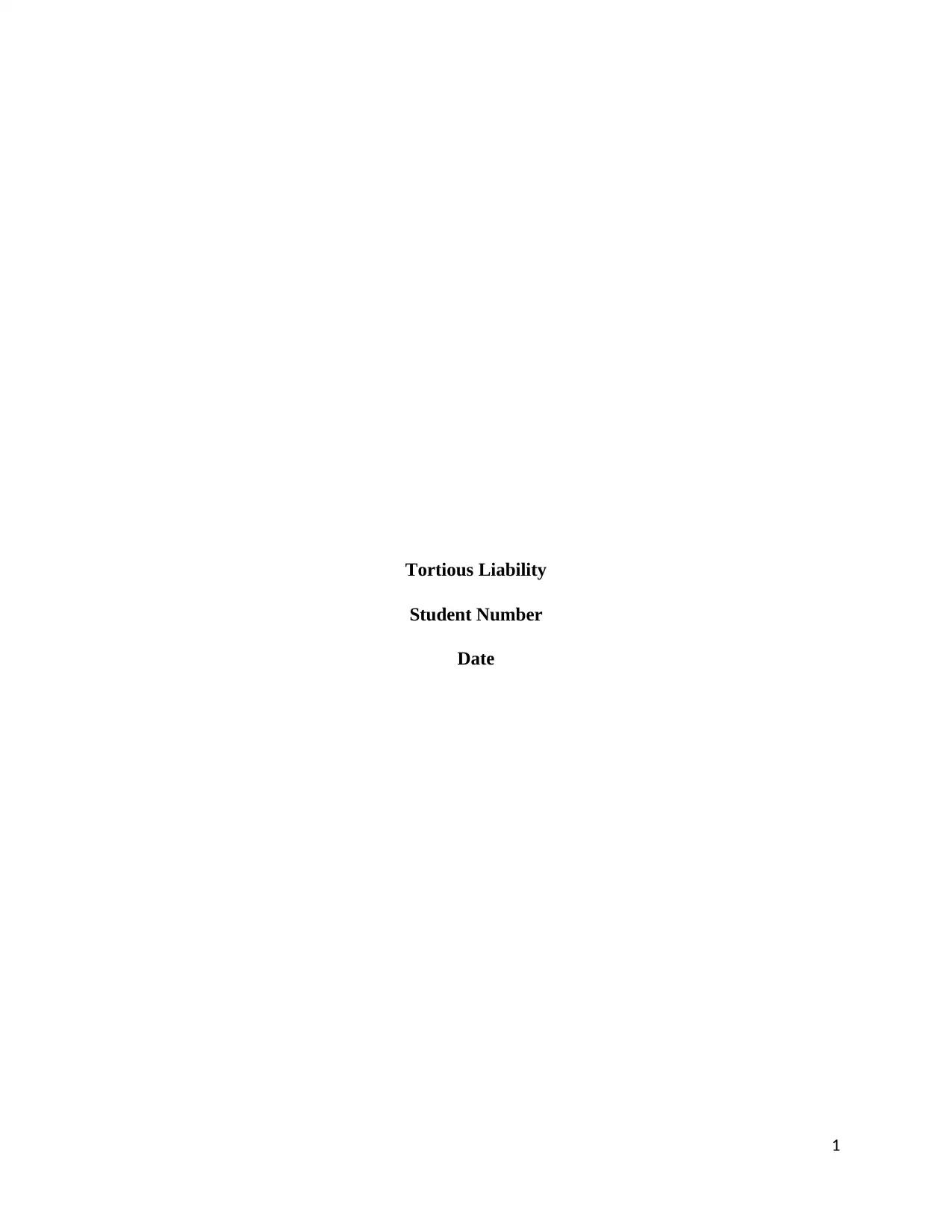
Tortious Liability
Student Number
Date
1
Student Number
Date
1
Paraphrase This Document
Need a fresh take? Get an instant paraphrase of this document with our AI Paraphraser
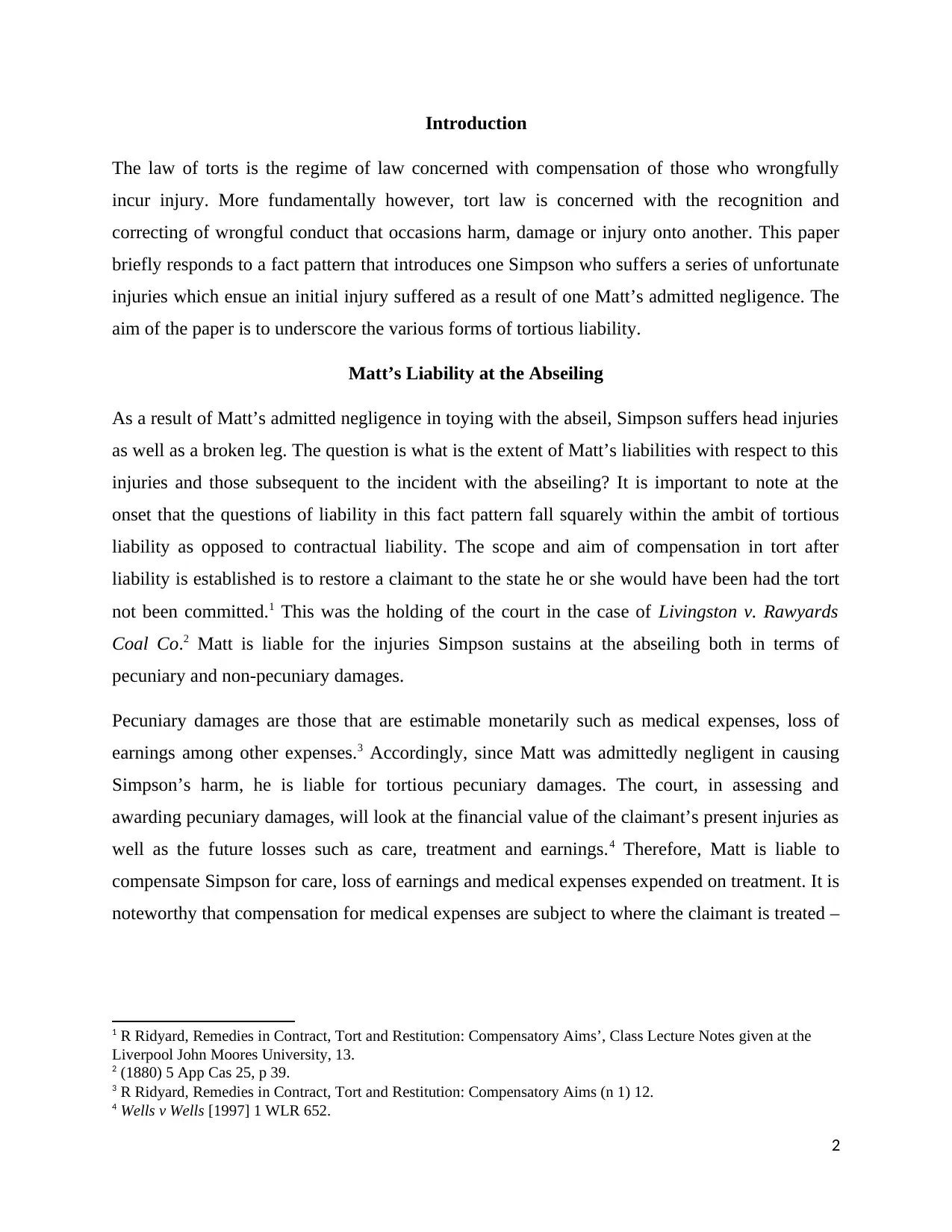
Introduction
The law of torts is the regime of law concerned with compensation of those who wrongfully
incur injury. More fundamentally however, tort law is concerned with the recognition and
correcting of wrongful conduct that occasions harm, damage or injury onto another. This paper
briefly responds to a fact pattern that introduces one Simpson who suffers a series of unfortunate
injuries which ensue an initial injury suffered as a result of one Matt’s admitted negligence. The
aim of the paper is to underscore the various forms of tortious liability.
Matt’s Liability at the Abseiling
As a result of Matt’s admitted negligence in toying with the abseil, Simpson suffers head injuries
as well as a broken leg. The question is what is the extent of Matt’s liabilities with respect to this
injuries and those subsequent to the incident with the abseiling? It is important to note at the
onset that the questions of liability in this fact pattern fall squarely within the ambit of tortious
liability as opposed to contractual liability. The scope and aim of compensation in tort after
liability is established is to restore a claimant to the state he or she would have been had the tort
not been committed.1 This was the holding of the court in the case of Livingston v. Rawyards
Coal Co.2 Matt is liable for the injuries Simpson sustains at the abseiling both in terms of
pecuniary and non-pecuniary damages.
Pecuniary damages are those that are estimable monetarily such as medical expenses, loss of
earnings among other expenses.3 Accordingly, since Matt was admittedly negligent in causing
Simpson’s harm, he is liable for tortious pecuniary damages. The court, in assessing and
awarding pecuniary damages, will look at the financial value of the claimant’s present injuries as
well as the future losses such as care, treatment and earnings.4 Therefore, Matt is liable to
compensate Simpson for care, loss of earnings and medical expenses expended on treatment. It is
noteworthy that compensation for medical expenses are subject to where the claimant is treated –
1 R Ridyard, Remedies in Contract, Tort and Restitution: Compensatory Aims’, Class Lecture Notes given at the
Liverpool John Moores University, 13.
2 (1880) 5 App Cas 25, p 39.
3 R Ridyard, Remedies in Contract, Tort and Restitution: Compensatory Aims (n 1) 12.
4 Wells v Wells [1997] 1 WLR 652.
2
The law of torts is the regime of law concerned with compensation of those who wrongfully
incur injury. More fundamentally however, tort law is concerned with the recognition and
correcting of wrongful conduct that occasions harm, damage or injury onto another. This paper
briefly responds to a fact pattern that introduces one Simpson who suffers a series of unfortunate
injuries which ensue an initial injury suffered as a result of one Matt’s admitted negligence. The
aim of the paper is to underscore the various forms of tortious liability.
Matt’s Liability at the Abseiling
As a result of Matt’s admitted negligence in toying with the abseil, Simpson suffers head injuries
as well as a broken leg. The question is what is the extent of Matt’s liabilities with respect to this
injuries and those subsequent to the incident with the abseiling? It is important to note at the
onset that the questions of liability in this fact pattern fall squarely within the ambit of tortious
liability as opposed to contractual liability. The scope and aim of compensation in tort after
liability is established is to restore a claimant to the state he or she would have been had the tort
not been committed.1 This was the holding of the court in the case of Livingston v. Rawyards
Coal Co.2 Matt is liable for the injuries Simpson sustains at the abseiling both in terms of
pecuniary and non-pecuniary damages.
Pecuniary damages are those that are estimable monetarily such as medical expenses, loss of
earnings among other expenses.3 Accordingly, since Matt was admittedly negligent in causing
Simpson’s harm, he is liable for tortious pecuniary damages. The court, in assessing and
awarding pecuniary damages, will look at the financial value of the claimant’s present injuries as
well as the future losses such as care, treatment and earnings.4 Therefore, Matt is liable to
compensate Simpson for care, loss of earnings and medical expenses expended on treatment. It is
noteworthy that compensation for medical expenses are subject to where the claimant is treated –
1 R Ridyard, Remedies in Contract, Tort and Restitution: Compensatory Aims’, Class Lecture Notes given at the
Liverpool John Moores University, 13.
2 (1880) 5 App Cas 25, p 39.
3 R Ridyard, Remedies in Contract, Tort and Restitution: Compensatory Aims (n 1) 12.
4 Wells v Wells [1997] 1 WLR 652.
2

whether private or not.5 If the claimant’s option is treatment by the National Health Service, the
claimant’s savings set off the loss of earnings.6
Non-pecuniary damages is compensation that covers intangible aspects such as suffering, shock,
pain and losing physical amenity.7 In this regard, Matt is liable to Simpson for injuries he
sustained as well as the subsequent inability by Simpson to enjoy life. Section 1(1)(b) of the
Administration of Justice Act (1982) provides that damages are awardable by the court for pain
and suffering attributable to either the injury of consequent surgical operations. The court of
appeal laid down the tariff used in calculating loss of amenity.8
On The Way to the Hospital
The fact pattern reveals that the ambulance in which Simpson was travelling to hospital was hit
by a falling tree that resulted from a gust of wind, thereby delaying his arrival at the hospital. The
question here is to what extent is Matt liable for this accident and delay?
The general rule with regard to this kind of a scenario is that a defendant will be precluded from
liability in a negligence claim if it is not reasonably foreseeable that the defendant was
responsible.9 In other words liability for negligent damage is contingent upon the foreseeability
of such damage.10 Therefore, if the damage was not foreseeable during the time it was inflicted,
the person who caused it cannot be held liable. There is no wrongful action on the part of the
person who inflicts damage if that damage is not foreseeable since such a person does not really
have a choice among alternatives ways to act.11 Therefore, applying this legal principle to the fact
pattern, neither Matt nor the ambulance driver are liable for the falling tree and the delay. This is
because it was not and could not have been reasonably foreseeable that the tree would fall. The
tree fell solely due to the freak gust of wind. Therefore, Matt is absolved from liability.
At The Hospital
5 R Riryard, Compensatory Damages for Personal Injury and Death, Class Lecture Notes given at the Liverpool John
Moores University, 29; See also Law Reform (Personal Injuries) Act 1948, s.2 United Kingdom.
6 See the Administration of Justice Act 1982, s. 5.
7 Riryard, Compensatory Damages for Personal Injury and Death (n 5) 31.
8 See generally Heil v Rankin [2000] EWCA Civ 187.
9 Donoghue v Stevenson [1932] AC 562 at 580.
10 RWV Horton. Winfield and Jolowicz on Tort (Vol. 15. London Sweet & Maxwell 1998) 132.
11 E Richard. ‘A theory of strict liability’ (1973) 2(1) The Journal of Legal Studies, 168-71.
3
claimant’s savings set off the loss of earnings.6
Non-pecuniary damages is compensation that covers intangible aspects such as suffering, shock,
pain and losing physical amenity.7 In this regard, Matt is liable to Simpson for injuries he
sustained as well as the subsequent inability by Simpson to enjoy life. Section 1(1)(b) of the
Administration of Justice Act (1982) provides that damages are awardable by the court for pain
and suffering attributable to either the injury of consequent surgical operations. The court of
appeal laid down the tariff used in calculating loss of amenity.8
On The Way to the Hospital
The fact pattern reveals that the ambulance in which Simpson was travelling to hospital was hit
by a falling tree that resulted from a gust of wind, thereby delaying his arrival at the hospital. The
question here is to what extent is Matt liable for this accident and delay?
The general rule with regard to this kind of a scenario is that a defendant will be precluded from
liability in a negligence claim if it is not reasonably foreseeable that the defendant was
responsible.9 In other words liability for negligent damage is contingent upon the foreseeability
of such damage.10 Therefore, if the damage was not foreseeable during the time it was inflicted,
the person who caused it cannot be held liable. There is no wrongful action on the part of the
person who inflicts damage if that damage is not foreseeable since such a person does not really
have a choice among alternatives ways to act.11 Therefore, applying this legal principle to the fact
pattern, neither Matt nor the ambulance driver are liable for the falling tree and the delay. This is
because it was not and could not have been reasonably foreseeable that the tree would fall. The
tree fell solely due to the freak gust of wind. Therefore, Matt is absolved from liability.
At The Hospital
5 R Riryard, Compensatory Damages for Personal Injury and Death, Class Lecture Notes given at the Liverpool John
Moores University, 29; See also Law Reform (Personal Injuries) Act 1948, s.2 United Kingdom.
6 See the Administration of Justice Act 1982, s. 5.
7 Riryard, Compensatory Damages for Personal Injury and Death (n 5) 31.
8 See generally Heil v Rankin [2000] EWCA Civ 187.
9 Donoghue v Stevenson [1932] AC 562 at 580.
10 RWV Horton. Winfield and Jolowicz on Tort (Vol. 15. London Sweet & Maxwell 1998) 132.
11 E Richard. ‘A theory of strict liability’ (1973) 2(1) The Journal of Legal Studies, 168-71.
3
⊘ This is a preview!⊘
Do you want full access?
Subscribe today to unlock all pages.

Trusted by 1+ million students worldwide
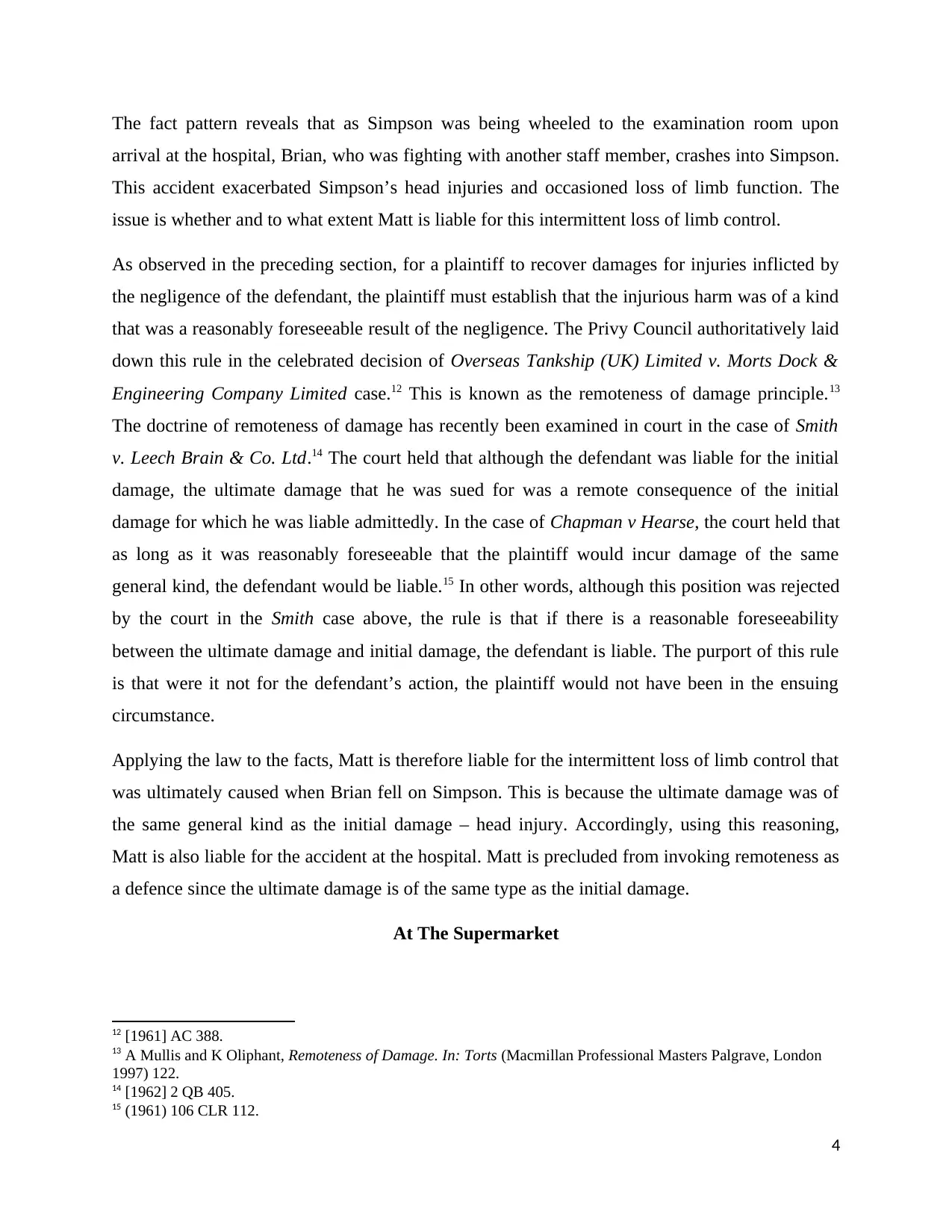
The fact pattern reveals that as Simpson was being wheeled to the examination room upon
arrival at the hospital, Brian, who was fighting with another staff member, crashes into Simpson.
This accident exacerbated Simpson’s head injuries and occasioned loss of limb function. The
issue is whether and to what extent Matt is liable for this intermittent loss of limb control.
As observed in the preceding section, for a plaintiff to recover damages for injuries inflicted by
the negligence of the defendant, the plaintiff must establish that the injurious harm was of a kind
that was a reasonably foreseeable result of the negligence. The Privy Council authoritatively laid
down this rule in the celebrated decision of Overseas Tankship (UK) Limited v. Morts Dock &
Engineering Company Limited case.12 This is known as the remoteness of damage principle.13
The doctrine of remoteness of damage has recently been examined in court in the case of Smith
v. Leech Brain & Co. Ltd.14 The court held that although the defendant was liable for the initial
damage, the ultimate damage that he was sued for was a remote consequence of the initial
damage for which he was liable admittedly. In the case of Chapman v Hearse, the court held that
as long as it was reasonably foreseeable that the plaintiff would incur damage of the same
general kind, the defendant would be liable.15 In other words, although this position was rejected
by the court in the Smith case above, the rule is that if there is a reasonable foreseeability
between the ultimate damage and initial damage, the defendant is liable. The purport of this rule
is that were it not for the defendant’s action, the plaintiff would not have been in the ensuing
circumstance.
Applying the law to the facts, Matt is therefore liable for the intermittent loss of limb control that
was ultimately caused when Brian fell on Simpson. This is because the ultimate damage was of
the same general kind as the initial damage – head injury. Accordingly, using this reasoning,
Matt is also liable for the accident at the hospital. Matt is precluded from invoking remoteness as
a defence since the ultimate damage is of the same type as the initial damage.
At The Supermarket
12 [1961] AC 388.
13 A Mullis and K Oliphant, Remoteness of Damage. In: Torts (Macmillan Professional Masters Palgrave, London
1997) 122.
14 [1962] 2 QB 405.
15 (1961) 106 CLR 112.
4
arrival at the hospital, Brian, who was fighting with another staff member, crashes into Simpson.
This accident exacerbated Simpson’s head injuries and occasioned loss of limb function. The
issue is whether and to what extent Matt is liable for this intermittent loss of limb control.
As observed in the preceding section, for a plaintiff to recover damages for injuries inflicted by
the negligence of the defendant, the plaintiff must establish that the injurious harm was of a kind
that was a reasonably foreseeable result of the negligence. The Privy Council authoritatively laid
down this rule in the celebrated decision of Overseas Tankship (UK) Limited v. Morts Dock &
Engineering Company Limited case.12 This is known as the remoteness of damage principle.13
The doctrine of remoteness of damage has recently been examined in court in the case of Smith
v. Leech Brain & Co. Ltd.14 The court held that although the defendant was liable for the initial
damage, the ultimate damage that he was sued for was a remote consequence of the initial
damage for which he was liable admittedly. In the case of Chapman v Hearse, the court held that
as long as it was reasonably foreseeable that the plaintiff would incur damage of the same
general kind, the defendant would be liable.15 In other words, although this position was rejected
by the court in the Smith case above, the rule is that if there is a reasonable foreseeability
between the ultimate damage and initial damage, the defendant is liable. The purport of this rule
is that were it not for the defendant’s action, the plaintiff would not have been in the ensuing
circumstance.
Applying the law to the facts, Matt is therefore liable for the intermittent loss of limb control that
was ultimately caused when Brian fell on Simpson. This is because the ultimate damage was of
the same general kind as the initial damage – head injury. Accordingly, using this reasoning,
Matt is also liable for the accident at the hospital. Matt is precluded from invoking remoteness as
a defence since the ultimate damage is of the same type as the initial damage.
At The Supermarket
12 [1961] AC 388.
13 A Mullis and K Oliphant, Remoteness of Damage. In: Torts (Macmillan Professional Masters Palgrave, London
1997) 122.
14 [1962] 2 QB 405.
15 (1961) 106 CLR 112.
4
Paraphrase This Document
Need a fresh take? Get an instant paraphrase of this document with our AI Paraphraser
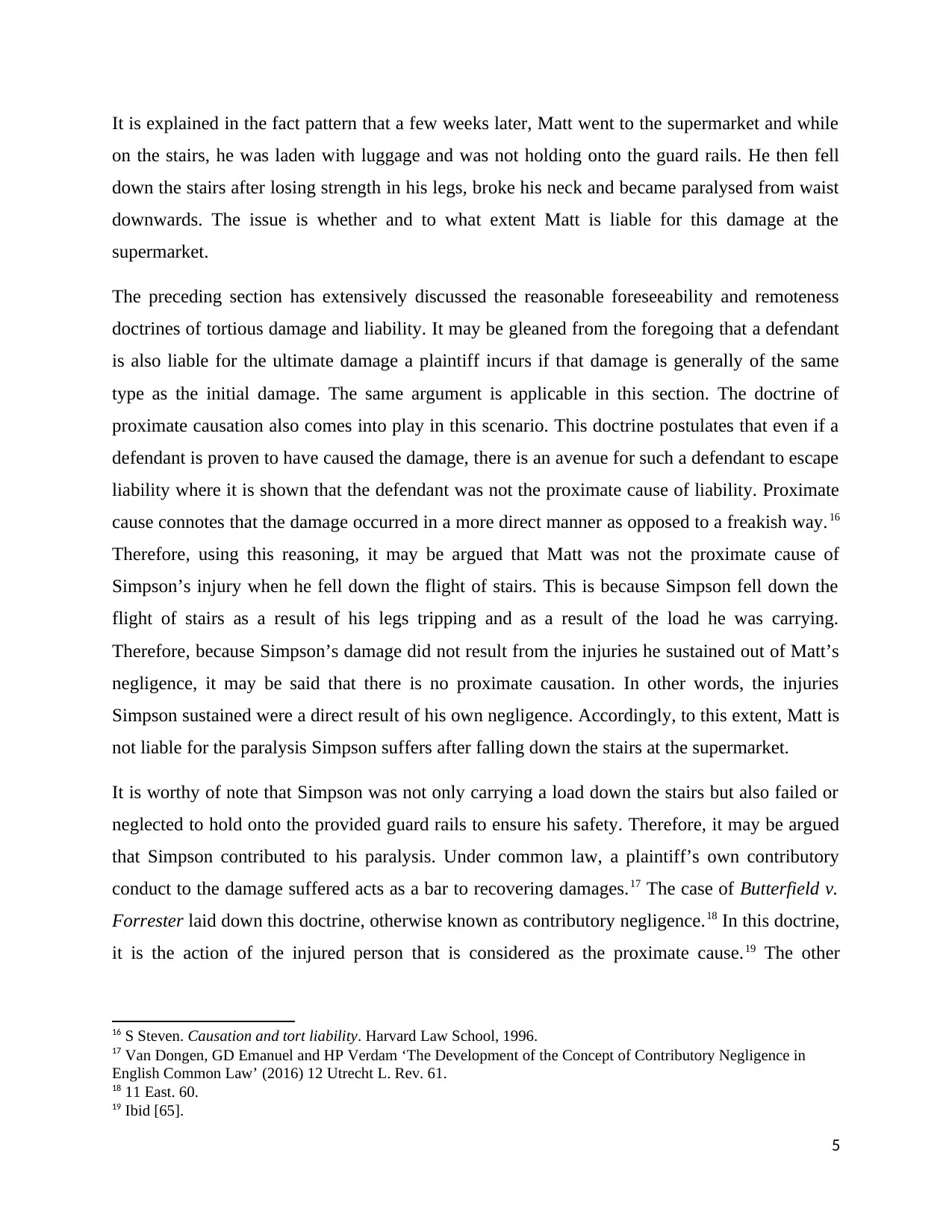
It is explained in the fact pattern that a few weeks later, Matt went to the supermarket and while
on the stairs, he was laden with luggage and was not holding onto the guard rails. He then fell
down the stairs after losing strength in his legs, broke his neck and became paralysed from waist
downwards. The issue is whether and to what extent Matt is liable for this damage at the
supermarket.
The preceding section has extensively discussed the reasonable foreseeability and remoteness
doctrines of tortious damage and liability. It may be gleaned from the foregoing that a defendant
is also liable for the ultimate damage a plaintiff incurs if that damage is generally of the same
type as the initial damage. The same argument is applicable in this section. The doctrine of
proximate causation also comes into play in this scenario. This doctrine postulates that even if a
defendant is proven to have caused the damage, there is an avenue for such a defendant to escape
liability where it is shown that the defendant was not the proximate cause of liability. Proximate
cause connotes that the damage occurred in a more direct manner as opposed to a freakish way.16
Therefore, using this reasoning, it may be argued that Matt was not the proximate cause of
Simpson’s injury when he fell down the flight of stairs. This is because Simpson fell down the
flight of stairs as a result of his legs tripping and as a result of the load he was carrying.
Therefore, because Simpson’s damage did not result from the injuries he sustained out of Matt’s
negligence, it may be said that there is no proximate causation. In other words, the injuries
Simpson sustained were a direct result of his own negligence. Accordingly, to this extent, Matt is
not liable for the paralysis Simpson suffers after falling down the stairs at the supermarket.
It is worthy of note that Simpson was not only carrying a load down the stairs but also failed or
neglected to hold onto the provided guard rails to ensure his safety. Therefore, it may be argued
that Simpson contributed to his paralysis. Under common law, a plaintiff’s own contributory
conduct to the damage suffered acts as a bar to recovering damages.17 The case of Butterfield v.
Forrester laid down this doctrine, otherwise known as contributory negligence.18 In this doctrine,
it is the action of the injured person that is considered as the proximate cause.19 The other
16 S Steven. Causation and tort liability. Harvard Law School, 1996.
17 Van Dongen, GD Emanuel and HP Verdam ‘The Development of the Concept of Contributory Negligence in
English Common Law’ (2016) 12 Utrecht L. Rev. 61.
18 11 East. 60.
19 Ibid [65].
5
on the stairs, he was laden with luggage and was not holding onto the guard rails. He then fell
down the stairs after losing strength in his legs, broke his neck and became paralysed from waist
downwards. The issue is whether and to what extent Matt is liable for this damage at the
supermarket.
The preceding section has extensively discussed the reasonable foreseeability and remoteness
doctrines of tortious damage and liability. It may be gleaned from the foregoing that a defendant
is also liable for the ultimate damage a plaintiff incurs if that damage is generally of the same
type as the initial damage. The same argument is applicable in this section. The doctrine of
proximate causation also comes into play in this scenario. This doctrine postulates that even if a
defendant is proven to have caused the damage, there is an avenue for such a defendant to escape
liability where it is shown that the defendant was not the proximate cause of liability. Proximate
cause connotes that the damage occurred in a more direct manner as opposed to a freakish way.16
Therefore, using this reasoning, it may be argued that Matt was not the proximate cause of
Simpson’s injury when he fell down the flight of stairs. This is because Simpson fell down the
flight of stairs as a result of his legs tripping and as a result of the load he was carrying.
Therefore, because Simpson’s damage did not result from the injuries he sustained out of Matt’s
negligence, it may be said that there is no proximate causation. In other words, the injuries
Simpson sustained were a direct result of his own negligence. Accordingly, to this extent, Matt is
not liable for the paralysis Simpson suffers after falling down the stairs at the supermarket.
It is worthy of note that Simpson was not only carrying a load down the stairs but also failed or
neglected to hold onto the provided guard rails to ensure his safety. Therefore, it may be argued
that Simpson contributed to his paralysis. Under common law, a plaintiff’s own contributory
conduct to the damage suffered acts as a bar to recovering damages.17 The case of Butterfield v.
Forrester laid down this doctrine, otherwise known as contributory negligence.18 In this doctrine,
it is the action of the injured person that is considered as the proximate cause.19 The other
16 S Steven. Causation and tort liability. Harvard Law School, 1996.
17 Van Dongen, GD Emanuel and HP Verdam ‘The Development of the Concept of Contributory Negligence in
English Common Law’ (2016) 12 Utrecht L. Rev. 61.
18 11 East. 60.
19 Ibid [65].
5
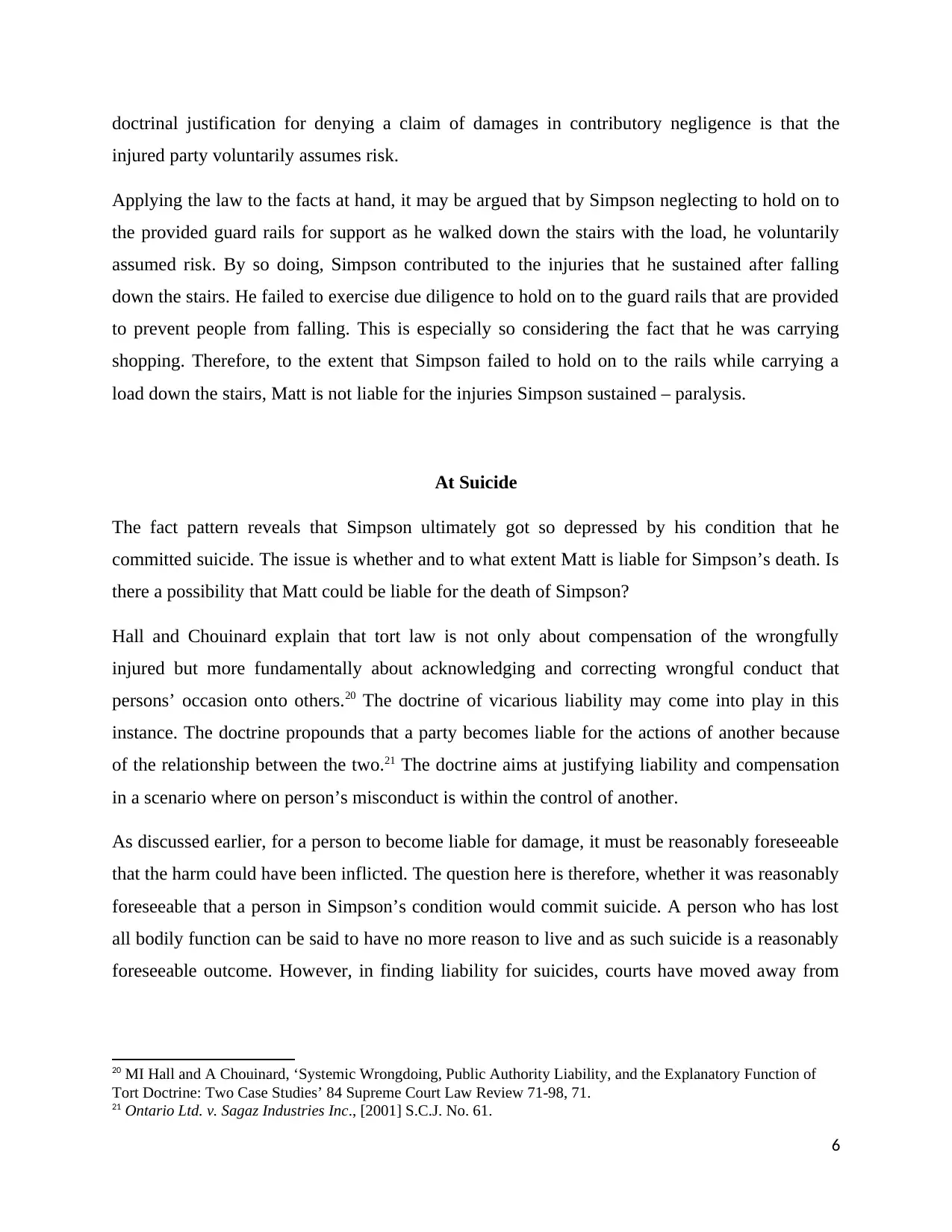
doctrinal justification for denying a claim of damages in contributory negligence is that the
injured party voluntarily assumes risk.
Applying the law to the facts at hand, it may be argued that by Simpson neglecting to hold on to
the provided guard rails for support as he walked down the stairs with the load, he voluntarily
assumed risk. By so doing, Simpson contributed to the injuries that he sustained after falling
down the stairs. He failed to exercise due diligence to hold on to the guard rails that are provided
to prevent people from falling. This is especially so considering the fact that he was carrying
shopping. Therefore, to the extent that Simpson failed to hold on to the rails while carrying a
load down the stairs, Matt is not liable for the injuries Simpson sustained – paralysis.
At Suicide
The fact pattern reveals that Simpson ultimately got so depressed by his condition that he
committed suicide. The issue is whether and to what extent Matt is liable for Simpson’s death. Is
there a possibility that Matt could be liable for the death of Simpson?
Hall and Chouinard explain that tort law is not only about compensation of the wrongfully
injured but more fundamentally about acknowledging and correcting wrongful conduct that
persons’ occasion onto others.20 The doctrine of vicarious liability may come into play in this
instance. The doctrine propounds that a party becomes liable for the actions of another because
of the relationship between the two.21 The doctrine aims at justifying liability and compensation
in a scenario where on person’s misconduct is within the control of another.
As discussed earlier, for a person to become liable for damage, it must be reasonably foreseeable
that the harm could have been inflicted. The question here is therefore, whether it was reasonably
foreseeable that a person in Simpson’s condition would commit suicide. A person who has lost
all bodily function can be said to have no more reason to live and as such suicide is a reasonably
foreseeable outcome. However, in finding liability for suicides, courts have moved away from
20 MI Hall and A Chouinard, ‘Systemic Wrongdoing, Public Authority Liability, and the Explanatory Function of
Tort Doctrine: Two Case Studies’ 84 Supreme Court Law Review 71-98, 71.
21 Ontario Ltd. v. Sagaz Industries Inc., [2001] S.C.J. No. 61.
6
injured party voluntarily assumes risk.
Applying the law to the facts at hand, it may be argued that by Simpson neglecting to hold on to
the provided guard rails for support as he walked down the stairs with the load, he voluntarily
assumed risk. By so doing, Simpson contributed to the injuries that he sustained after falling
down the stairs. He failed to exercise due diligence to hold on to the guard rails that are provided
to prevent people from falling. This is especially so considering the fact that he was carrying
shopping. Therefore, to the extent that Simpson failed to hold on to the rails while carrying a
load down the stairs, Matt is not liable for the injuries Simpson sustained – paralysis.
At Suicide
The fact pattern reveals that Simpson ultimately got so depressed by his condition that he
committed suicide. The issue is whether and to what extent Matt is liable for Simpson’s death. Is
there a possibility that Matt could be liable for the death of Simpson?
Hall and Chouinard explain that tort law is not only about compensation of the wrongfully
injured but more fundamentally about acknowledging and correcting wrongful conduct that
persons’ occasion onto others.20 The doctrine of vicarious liability may come into play in this
instance. The doctrine propounds that a party becomes liable for the actions of another because
of the relationship between the two.21 The doctrine aims at justifying liability and compensation
in a scenario where on person’s misconduct is within the control of another.
As discussed earlier, for a person to become liable for damage, it must be reasonably foreseeable
that the harm could have been inflicted. The question here is therefore, whether it was reasonably
foreseeable that a person in Simpson’s condition would commit suicide. A person who has lost
all bodily function can be said to have no more reason to live and as such suicide is a reasonably
foreseeable outcome. However, in finding liability for suicides, courts have moved away from
20 MI Hall and A Chouinard, ‘Systemic Wrongdoing, Public Authority Liability, and the Explanatory Function of
Tort Doctrine: Two Case Studies’ 84 Supreme Court Law Review 71-98, 71.
21 Ontario Ltd. v. Sagaz Industries Inc., [2001] S.C.J. No. 61.
6
⊘ This is a preview!⊘
Do you want full access?
Subscribe today to unlock all pages.

Trusted by 1+ million students worldwide
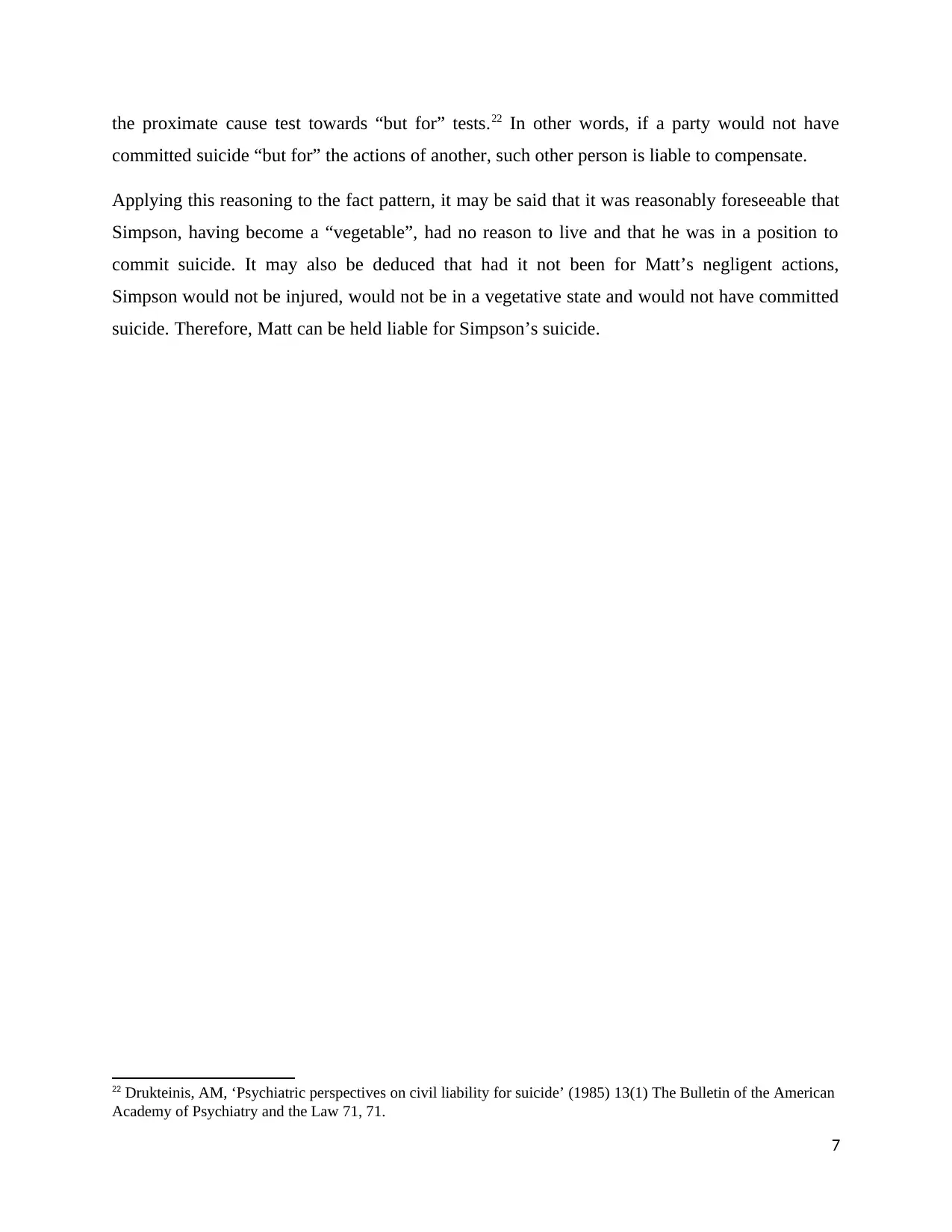
the proximate cause test towards “but for” tests.22 In other words, if a party would not have
committed suicide “but for” the actions of another, such other person is liable to compensate.
Applying this reasoning to the fact pattern, it may be said that it was reasonably foreseeable that
Simpson, having become a “vegetable”, had no reason to live and that he was in a position to
commit suicide. It may also be deduced that had it not been for Matt’s negligent actions,
Simpson would not be injured, would not be in a vegetative state and would not have committed
suicide. Therefore, Matt can be held liable for Simpson’s suicide.
22 Drukteinis, AM, ‘Psychiatric perspectives on civil liability for suicide’ (1985) 13(1) The Bulletin of the American
Academy of Psychiatry and the Law 71, 71.
7
committed suicide “but for” the actions of another, such other person is liable to compensate.
Applying this reasoning to the fact pattern, it may be said that it was reasonably foreseeable that
Simpson, having become a “vegetable”, had no reason to live and that he was in a position to
commit suicide. It may also be deduced that had it not been for Matt’s negligent actions,
Simpson would not be injured, would not be in a vegetative state and would not have committed
suicide. Therefore, Matt can be held liable for Simpson’s suicide.
22 Drukteinis, AM, ‘Psychiatric perspectives on civil liability for suicide’ (1985) 13(1) The Bulletin of the American
Academy of Psychiatry and the Law 71, 71.
7
Paraphrase This Document
Need a fresh take? Get an instant paraphrase of this document with our AI Paraphraser
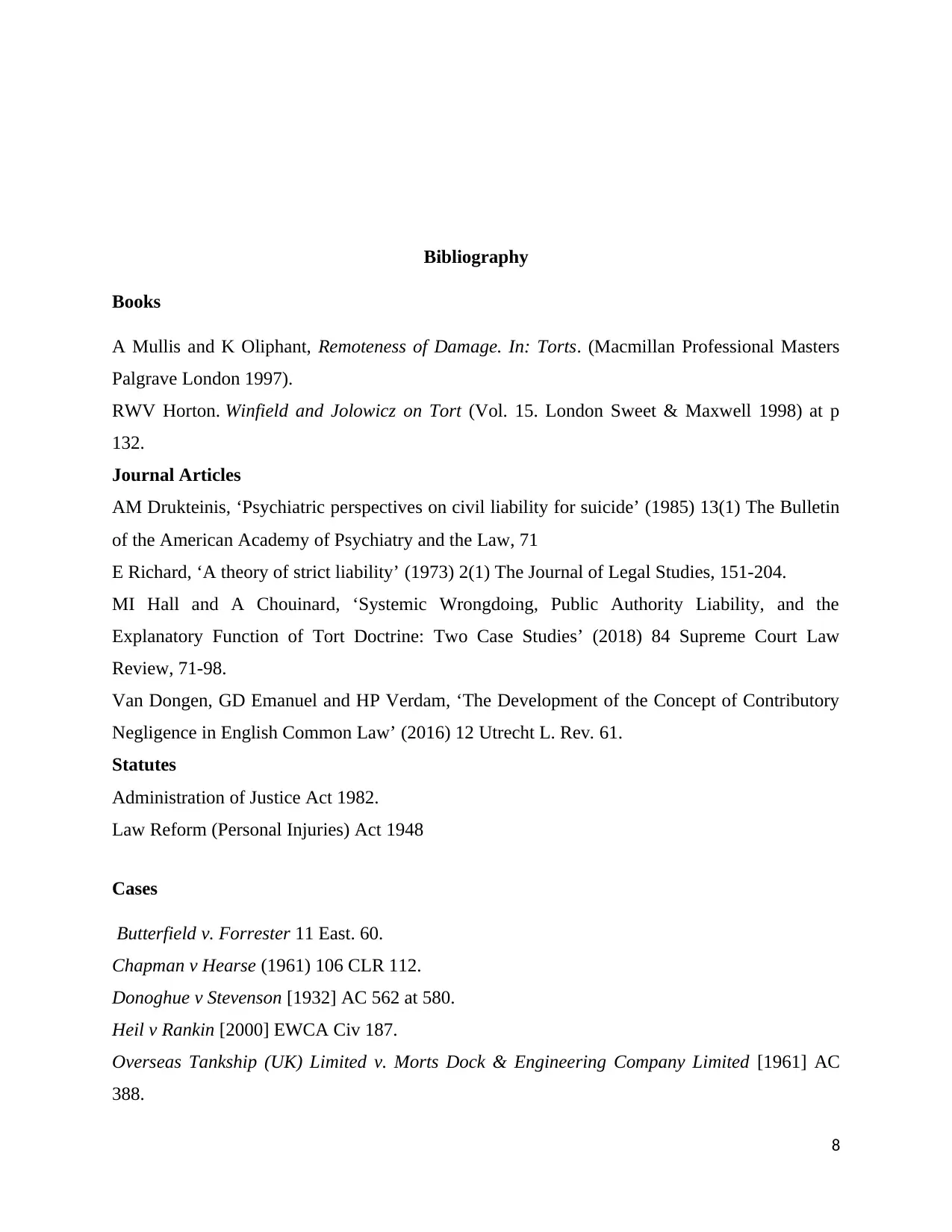
Bibliography
Books
A Mullis and K Oliphant, Remoteness of Damage. In: Torts. (Macmillan Professional Masters
Palgrave London 1997).
RWV Horton. Winfield and Jolowicz on Tort (Vol. 15. London Sweet & Maxwell 1998) at p
132.
Journal Articles
AM Drukteinis, ‘Psychiatric perspectives on civil liability for suicide’ (1985) 13(1) The Bulletin
of the American Academy of Psychiatry and the Law, 71
E Richard, ‘A theory of strict liability’ (1973) 2(1) The Journal of Legal Studies, 151-204.
MI Hall and A Chouinard, ‘Systemic Wrongdoing, Public Authority Liability, and the
Explanatory Function of Tort Doctrine: Two Case Studies’ (2018) 84 Supreme Court Law
Review, 71-98.
Van Dongen, GD Emanuel and HP Verdam, ‘The Development of the Concept of Contributory
Negligence in English Common Law’ (2016) 12 Utrecht L. Rev. 61.
Statutes
Administration of Justice Act 1982.
Law Reform (Personal Injuries) Act 1948
Cases
Butterfield v. Forrester 11 East. 60.
Chapman v Hearse (1961) 106 CLR 112.
Donoghue v Stevenson [1932] AC 562 at 580.
Heil v Rankin [2000] EWCA Civ 187.
Overseas Tankship (UK) Limited v. Morts Dock & Engineering Company Limited [1961] AC
388.
8
Books
A Mullis and K Oliphant, Remoteness of Damage. In: Torts. (Macmillan Professional Masters
Palgrave London 1997).
RWV Horton. Winfield and Jolowicz on Tort (Vol. 15. London Sweet & Maxwell 1998) at p
132.
Journal Articles
AM Drukteinis, ‘Psychiatric perspectives on civil liability for suicide’ (1985) 13(1) The Bulletin
of the American Academy of Psychiatry and the Law, 71
E Richard, ‘A theory of strict liability’ (1973) 2(1) The Journal of Legal Studies, 151-204.
MI Hall and A Chouinard, ‘Systemic Wrongdoing, Public Authority Liability, and the
Explanatory Function of Tort Doctrine: Two Case Studies’ (2018) 84 Supreme Court Law
Review, 71-98.
Van Dongen, GD Emanuel and HP Verdam, ‘The Development of the Concept of Contributory
Negligence in English Common Law’ (2016) 12 Utrecht L. Rev. 61.
Statutes
Administration of Justice Act 1982.
Law Reform (Personal Injuries) Act 1948
Cases
Butterfield v. Forrester 11 East. 60.
Chapman v Hearse (1961) 106 CLR 112.
Donoghue v Stevenson [1932] AC 562 at 580.
Heil v Rankin [2000] EWCA Civ 187.
Overseas Tankship (UK) Limited v. Morts Dock & Engineering Company Limited [1961] AC
388.
8
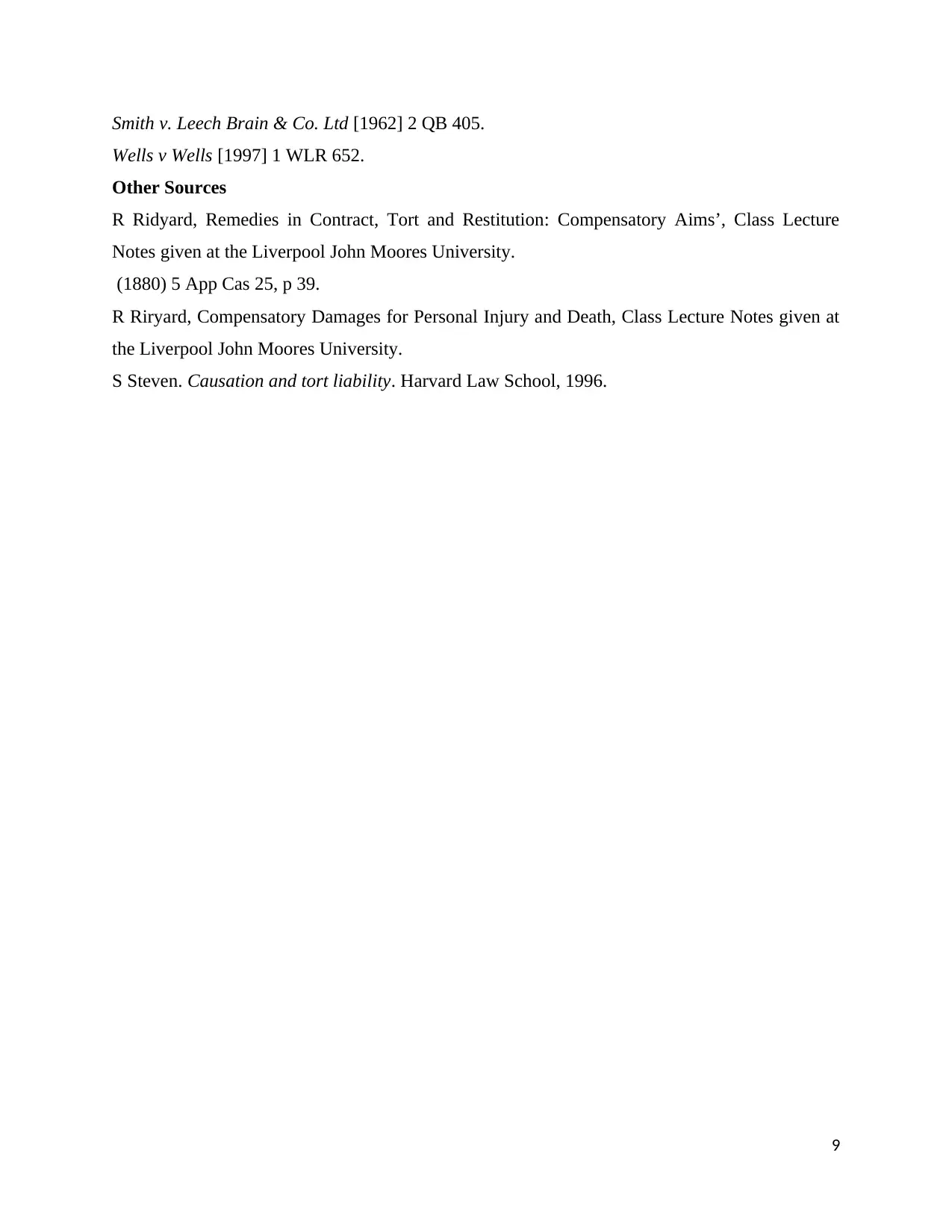
Smith v. Leech Brain & Co. Ltd [1962] 2 QB 405.
Wells v Wells [1997] 1 WLR 652.
Other Sources
R Ridyard, Remedies in Contract, Tort and Restitution: Compensatory Aims’, Class Lecture
Notes given at the Liverpool John Moores University.
(1880) 5 App Cas 25, p 39.
R Riryard, Compensatory Damages for Personal Injury and Death, Class Lecture Notes given at
the Liverpool John Moores University.
S Steven. Causation and tort liability. Harvard Law School, 1996.
9
Wells v Wells [1997] 1 WLR 652.
Other Sources
R Ridyard, Remedies in Contract, Tort and Restitution: Compensatory Aims’, Class Lecture
Notes given at the Liverpool John Moores University.
(1880) 5 App Cas 25, p 39.
R Riryard, Compensatory Damages for Personal Injury and Death, Class Lecture Notes given at
the Liverpool John Moores University.
S Steven. Causation and tort liability. Harvard Law School, 1996.
9
⊘ This is a preview!⊘
Do you want full access?
Subscribe today to unlock all pages.

Trusted by 1+ million students worldwide
1 out of 9
Related Documents
Your All-in-One AI-Powered Toolkit for Academic Success.
+13062052269
info@desklib.com
Available 24*7 on WhatsApp / Email
![[object Object]](/_next/static/media/star-bottom.7253800d.svg)
Unlock your academic potential
Copyright © 2020–2025 A2Z Services. All Rights Reserved. Developed and managed by ZUCOL.



